In recent years, the agricultural sector has experienced a significant revolution, as it has embraced advanced technologies to improve efficiency, productivity, and sustainability. One such technology that has emerged as a valuable asset is the Internet of Things (IoT), which presents numerous opportunities to transform and elevate conventional farming methods. The implementation of IoT in agriculture has become a novel approach to unlock the full potential of farming.
What is IoT Technology?
Before we dive into the benefits of IoT in Agriculture , let’s first understand what IoT technology is. IoT refers to the connection of everyday objects to the internet, allowing them to send and receive data. These objects can range from smart devices like phones and watches to household appliances and even vehicles.
In agriculture , IoT allows farmers to monitor crops, livestock, and soil conditions in real-time. This enables them to make informed decisions about when to irrigate or fertilize fields for optimal growth, as well as detect pests quickly before they become serious problems.
Educate farmers on the benefits of IoT technology

Many farmers may not be aware of the potential benefits of using IoT technology in their farming practices. It is important to educate them on how IoT can improve efficiency, reduce costs, and increase yields. This can be done through workshops, seminars, and demonstrations on farms.
IoT sensors and devices enable precision farming by collecting real-time data on soil moisture, temperature, and nutrient levels. Farmers can use this data to make informed decisions, optimizing irrigation, fertilization, and pest control for improved crop yield and resource efficiency.
Provide training and support
For farmers to fully utilize IoT technology, they need to be trained on how to use it effectively. This could include training on how to install and maintain IoT devices, how to interpret data, and how to integrate IoT technology into their existing farming practices. Ongoing technical support should also be provided to help troubleshoot any issues that may arise.
IoT-based smart irrigation systems help farmers manage water resources more efficiently.
Sensors in the field monitor soil moisture levels and weather conditions, allowing for automated irrigation adjustments to ensure optimal water usage.
Livestock Monitoring

IoT devices can be attached to livestock for continuous monitoring of health, location, and behavior. Farmers receive real-time alerts on any abnormalities, enabling early detection of diseases, tracking the animals, and optimizing feeding strategies.
Not all farms are the same, and therefore, solutions should be customized to meet the specific needs of each farm. This could include offering different packages for different farm sizes, or tailoring solutions to address specific challenges faced by different types of farms.
IoT devices provide continuous monitoring of weather conditions on the farm. Farmers can access accurate weather forecasts and make informed decisions on planting times, crop selection, and harvesting schedules.
Demonstrate the cost-saving potential
One of the main benefits of using technology in agriculture is the potential to save costs. This could be through more efficient use of resources such as water and fertilizer, early detection of pest infestations, or reducing labor costs. Demonstrating these cost-saving potentials can help convince farmers to invest in technology.
Collaborate with technology and agriculture experts

Collaboration between technology and agriculture experts is crucial in unlocking the full potential of technology in agriculture. Technology experts can provide innovative solutions and ideas, while agriculture experts can offer valuable insights into the specific needs and challenges of the industry. This collaboration can lead to the development of more effective and practical IoT solutions for agriculture.
IoT-enabled machinery and robotics enhance automation on the farm. Tractors, harvesters, and other equipment equipped with sensors can operate autonomously, optimizing tasks such as planting, harvesting, and weed control. Farmers can leverage advanced analytics tools to gain actionable insights, predict trends, and optimize farming practices for better outcomes.
Challenges in the Use of IoT in Agriculture
While the Internet of Things presents numerous opportunities for transforming agriculture, its adoption also comes with several challenges that need to be addressed for successful implementation.
Limited access to technology
One of the main challenges in the usage of IoT technology in agriculture is the limited access to technology in rural areas. Many farmers do not have access to reliable internet connections , knowledge or the necessary infrastructure to support devices. Providing training and support to farmers for the use of technology is essential for successful adoption.
Data management and analysis

These devices generate a large amount of data, and managing and analyzing this data can be a challenge for farmers. They may not have the necessary skills or resources to process and interpret the data to make informed decisions.
The large volume of data generated by IoT devices, including sensitive information, raises concerns about data privacy and security. Farmers may be hesitant to adopt solutions if they are unsure about the confidentiality and secure handling of their data.
As with any technology, there are security concerns when using it’s devices in agriculture. Farmers may be hesitant to adopt this technology due to the risk of data breaches and cyber attacks.
High cost of implementation
The cost of implementing technology in agriculture can be a barrier for small-scale farmers. The initial investment in sensors, devices, and connectivity can be expensive, making it difficult for farmers to adopt this technology. Implementing IoT solutions involves significant upfront costs for purchasing sensors, devices, and connectivity infrastructure. Many farmers, especially those with small or medium-sized operations, may find it challenging to make the initial investment.
Lack of technical expertise

Farmers may not have the required technical knowledge to operate and maintain devices. This can result in improper usage and maintenance of the technology, leading to inaccurate data and reduced efficiency.
Many farmers may lack the necessary technical skills and knowledge to deploy and manage devices effectively.
Environmental Conditions
IoT devices are exposed to harsh environmental conditions in agriculture, such as extreme temperatures, moisture, and dust. This can affect the performance and durability of the devices, leading to inaccurate data and frequent replacements. Developing rugged and weather-resistant devices is crucial for reliable operation in agricultural settings.


















